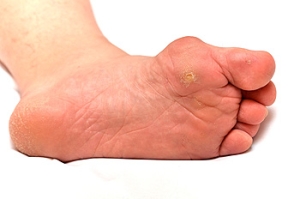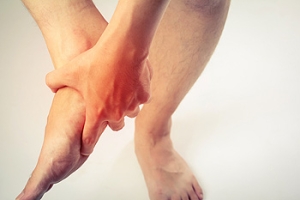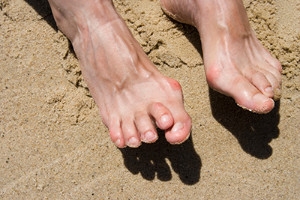
Wound Care
Diabetics must be wary of all wounds, regardless of depth or size. Diabetes, a chronic disease in which the body cannot properly use glucose the way it normally would, causes various complications that make wounds difficult to heal. Nerve damage or neuropathy will cause diabetics to have trouble feeling the pain of a blister or cut until the condition has significantly worsened or become infected. A diabetic’s weakened immune system can make even the most minor of wounds easily susceptible to infection. Diabetics are also more prone to developing narrow, clogged arteries, and are therefore more likely to develop wounds.
Wounds should be taken care of immediately after discovery, as even the smallest of wounds can become infected if enough bacteria build up within the wound. To remove dirt, wounds should be first rinsed under running water only. Soap, hydrogen peroxide, or iodine can irritate the injury and should be avoided. To prevent infection, apply antibiotic ointment to the wound and cover it with a bandage. The bandage should be changed daily. The skin around the wound may be cleaned with soap.
To prevent further exacerbation, see a doctor—especially if you have diabetes. Minor skin conditions can become larger problems if not properly inspected. As the wound heals, make sure to avoid applying pressure to the affected area.
Are Bunions a Deformity?
 If you have developed a bunion, you may be aware of a structural deformity of the foot. It is considered to be a bone disorder, and affects the big toe. Obvious symptoms that may accompany this condition can include a bony protrusion on the side of the big toe, pain and discomfort, and possibly limited mobility of the affected toe. Bunions typically cause the big toe to move toward the toe next to it, and this is the reason for the joint to extend outward. There are several reasons why bunions may occur, and these may include genetic traits, medical conditions such as arthritis, or foot injuries that may have happened. There are specific foot issues, which may develop as a result of having a bunion, including hammertoe, bursitis, or calluses. It is important to be under the care of a podiatrist who can properly diagnosis this condition, and offer correct treatment techniques.
If you have developed a bunion, you may be aware of a structural deformity of the foot. It is considered to be a bone disorder, and affects the big toe. Obvious symptoms that may accompany this condition can include a bony protrusion on the side of the big toe, pain and discomfort, and possibly limited mobility of the affected toe. Bunions typically cause the big toe to move toward the toe next to it, and this is the reason for the joint to extend outward. There are several reasons why bunions may occur, and these may include genetic traits, medical conditions such as arthritis, or foot injuries that may have happened. There are specific foot issues, which may develop as a result of having a bunion, including hammertoe, bursitis, or calluses. It is important to be under the care of a podiatrist who can properly diagnosis this condition, and offer correct treatment techniques.
If you are suffering from bunions, contact one of our podiatrists of New York Foot and Ankle. Our doctors can provide the care you need to keep you pain-free and on your feet.
What Is a Bunion?
A bunion is formed of swollen tissue or an enlargement of boney growth, usually located at the base joint of the toe that connects to the foot. The swelling occurs due to the bones in the big toe shifting inward, which impacts the other toes of the foot. This causes the area around the base of the big toe to become inflamed and painful.
Why Do Bunions Form?
Genetics – Susceptibility to bunions are often hereditary
Stress on the feet – Poorly fitted and uncomfortable footwear that places stress on feet, such as heels, can worsen existing bunions
How Are Bunions Diagnosed?
Doctors often perform two tests – blood tests and x-rays – when trying to diagnose bunions, especially in the early stages of development. Blood tests help determine if the foot pain is being caused by something else, such as arthritis, while x-rays provide a clear picture of your bone structure to your doctor.
How Are Bunions Treated?
- Refrain from wearing heels or similar shoes that cause discomfort
- Select wider shoes that can provide more comfort and reduce pain
- Anti-inflammatory and pain management drugs
- Orthotics or foot inserts
- Surgery
If you have any questions, please feel free to contact one of our offices located in Franklin Square, Bethpage, Brooklyn, and Massapequa, NY . We offer the newest diagnostic and treatment technologies for all your foot care needs.
What Are Bunions?
Bunions are large bony bumps at the base of the big toe. Medically known as hallux valgus, a bunion is a misalignment of the metatarsophalangeal joint, or big toe joint. The misalignment will generally worsen with time if left untreated.
The exact cause of bunions is unknown, with genetics seen as a potential cause. High heels and poorly-fitted footwear, rheumatoid arthritis, and heredity all seem to be potential factors behind the exacerbation of bunions. Women have been found to be more likely to develop bunions in comparison to men.
Bunions do not always produce symptoms. The best way to tell is if the big toe is pushing up against the next toe and there is a large protrusion at the base of the big toe. You may or may not feel pain. Redness, swelling, and restricted movement of the big toe may be present as well.
Podiatrists use a variety of methods to diagnose bunions. If there are symptoms present, podiatrists will first consider that it is a bunion. If not, a physical examination will be conducted to check function of the big toe. Finally, an X-ray may be taken to view the extent of the bunion and confirm it is a bunion.
Typically, nonsurgical methods are used to treat bunions, unless the bunion has become too misaligned. Orthotics, icing and resting the foot, roomier and better fitted shoes, taping the foot, and pain medication are usually utilized first. If the bunion doesn’t go away or causes extreme pain, surgery may be required. Surgeons will either remove part of the swollen tissue or bone to straighten the toe out.
If you have a bunion, it is recommended to see a podiatrist. The longer it is left untreated, the worse it may get. Podiatrists can properly diagnose and treat a bunion before it gets worse.
Who Is Prone to Developing Sever’s Disease?
 Children who frequently participate in running and jumping activities may complain about heel pain. It may be indicative of a condition that is referred to as Sever’s disease, which affects the growth plate in the heel. It may become irritated as a result of repetitive motions during specific sporting activities. Parents may notice that their child begins to walk with a limp, and the back of the heel may be swollen. It is beneficial to rest and elevate the affected foot, and it may help to relieve a portion of the pain when the calf muscles are stretched. If your active child complains of heel pain, it is advised that you schedule a consultation with a podiatrist who can properly diagnose and treat Sever’s disease.
Children who frequently participate in running and jumping activities may complain about heel pain. It may be indicative of a condition that is referred to as Sever’s disease, which affects the growth plate in the heel. It may become irritated as a result of repetitive motions during specific sporting activities. Parents may notice that their child begins to walk with a limp, and the back of the heel may be swollen. It is beneficial to rest and elevate the affected foot, and it may help to relieve a portion of the pain when the calf muscles are stretched. If your active child complains of heel pain, it is advised that you schedule a consultation with a podiatrist who can properly diagnose and treat Sever’s disease.
Sever's disease often occurs in children and teens. If your child is experiencing foot or ankle pain, see one of our podiatrists from New York Foot and Ankle. Our doctors can treat your child’s foot and ankle needs.
Sever’s Disease
Sever’s disease is also known as calcaneal apophysitis, which is a medical condition that causes heel pain I none or both feet. The disease is known to affect children between the ages of 8 and 14.
Sever’s disease occurs when part of the child’s heel known as the growth plate (calcaneal epiphysis) is attached to the Achilles tendon. This area can suffer injury when the muscles and tendons of the growing foot do not keep pace with bone growth. Therefore, the constant pain which one experiences at the back of the heel will make the child unable to put any weight on the heel. The child is then forced to walk on their toes.
Symptoms
Acute pain – Pain associated with Sever’s disease is usually felt in the heel when the child engages in physical activity such as walking, jumping and or running.
Highly active – Children who are very active are among the most susceptible in experiencing Sever’s disease, because of the stress and tension placed on their feet.
If you have any questions, please feel free to contact one of our offices located in Franklin Square, Bethpage, Brooklyn, and Massapequa, NY . We offer the newest diagnostic and treatment technologies for all your foot and ankle injuries.
Sever's Disease
Sever’s disease, also known as calcaneal apophysitis is a common bone disorder that occurs during childhood. The disease is defined as an inflammation of the growth plate in the heel. When a child has a growth spurt, his heel bone grows faster than the muscles, tendons, and ligaments in his leg. This disease is a result of overuse. The people who are most likely to be affected by this disease are children who are in a growth spurt, especially boys who are from the ages of 5 to 13 years old. 60% of children with Sever’s disease have both heels involved.
Symptoms of this disease are heel pain that intensifies during running and jumping activities. The pain is typically localized to the posterior part of the heel. Symptoms may be severe, and they can easily interfere with daily activities. Children who play soccer, baseball, and basketball are more likely to develop Sever’s disease.
Your doctor will diagnose your child based on his or her symptoms, x-rays are generally not helpful in diagnosing this disease. Your doctor may examine both heels and ask your child questions about his or her activity level in sports. Your doctor may then use the squeeze test on your child’s heel to see if there is any pain. Nevertheless, some doctors might still use x-rays to rule out any other issues such as fractures, infections, and tumors.
Sever’s disease can be prevented by maintaining good flexibility while your child is growing. Another prevention method is to wear good-quality shoes that have firm support and a shock-absorbent sole. Sever’s disease can be treated by ceasing any activity that causes heel pain. You should apply ice to the injured heel for 20 minutes 3 times a day. Additionally, orthotics should be used for children who have high arches, flat feet, or bowed legs.
If you suspect your child has Sever’s disease, you should make an appointment with your podiatrist to have his or her foot examined. Your doctor may recommend nonsteroidal anti-inflammatory drugs (NSAIDs), such as ibuprofen or naproxen to relieve pain. In more severe cases, your child may need a cast to rest his or her heel. Fortunately, Sever’s disease does not cause long-term foot problems. After treatment, your child should start to feel better within two weeks to two months.
Why Shoes Need to Fit Properly
 When shoes do not fit properly friction may occur, and this can lead to pain or discomfort. While simple discomfort can be annoying, improperly fitting shoes may also cause many other foot conditions to arise. These can include corns, which are small hardened bumps of skin. Bunions, that typically cause swelling on the joint of the big toe, and depending on the severity, may require surgery for permanent removal. And lastly blisters, which is when the skin forms a bubble that is filled with fluid and this is a direct result from excess friction. One solution to managing these various types of conditions includes proper shoe inserts, or custom orthotics. If you are afflicted with any ailment of the foot due to improperly fitting shoes, it is important to consult with a podiatrist. Podiatrists will be able to help and treat any issues that have developed, as well as provide preventative steps to keep them from getting worse.
When shoes do not fit properly friction may occur, and this can lead to pain or discomfort. While simple discomfort can be annoying, improperly fitting shoes may also cause many other foot conditions to arise. These can include corns, which are small hardened bumps of skin. Bunions, that typically cause swelling on the joint of the big toe, and depending on the severity, may require surgery for permanent removal. And lastly blisters, which is when the skin forms a bubble that is filled with fluid and this is a direct result from excess friction. One solution to managing these various types of conditions includes proper shoe inserts, or custom orthotics. If you are afflicted with any ailment of the foot due to improperly fitting shoes, it is important to consult with a podiatrist. Podiatrists will be able to help and treat any issues that have developed, as well as provide preventative steps to keep them from getting worse.
It is important to find shoes that fit you properly in order to avoid a variety of different foot problems. For more information about treatment, contact one of our podiatrists from New York Foot and Ankle. Our doctors will treat your foot and ankle needs.
Proper Shoe Fitting
Shoes have many different functions. They cushion our body weight, protect our feet, and allow us to safely play sports. You should always make sure that the shoes you wear fit you properly in order to avoid injuries and deformities such as: bunions, corns, calluses, hammertoes, plantar fasciitis, stress fractures, and more. It is important to note that although a certain pair of shoes might be a great fit for someone else, that doesn’t mean they will be a great fit for you. This is why you should always try on shoes before buying them to make sure they are worth the investment. Typically, shoes need to be replaced ever six months to one year of regular use.
Tips for Proper Shoe Fitting
- Select a shoe that is shaped like your foot
- Don’t buy shoes that fit too tight, expecting them to stretch to fit
- Make sure there is enough space (3/8” to ½”) for your longest toe at the end of each shoe when you are standing up
- Walk in the shoes to make sure they fit and feel right
- Don’t select shoes by the size marked inside the shoe, but by how the shoe fits your foot
The shoes you buy should always feel as good as they look. Shoes that fit properly will last longer, feel better, and improve your way of life each day.
If you have any questions, please feel free to contact one of our offices located in Franklin Square, Bethpage, Brooklyn, and Massapequa, NY . We offer the newest diagnostic and treatment technologies for all your foot care needs.
How to Get a Proper Shoe Fit
Many people suffer from foot problems because their shoes are poorly fitted. When shopping for a new pair of shoes, fashion usually triumphs over comfortability. A pair of well fitted shoes is essential in preventing foot problems and potential injuries.
Poorly fitted shoes can cause foot issues such as plantar fasciitis, bunions, hammertoes, ingrown toenails, and foot pain. Shoes such as high heels and sandals may cause problems for your feet. These shoes put the foot in an unnatural position for long periods and fail to provide good foot support. It is recommended to not wear either one for an extended period.
When you are trying on shoes, make sure they have enough space for your toes to move around. Shoes shouldn’t be cramped but also shouldn’t have too much room that your foot moves around in them. A snug shoe is a good choice. They should also provide good arch support and cushioning. Athletic shoes tend to offer both good support and cushioning. A degree of flexibility is necessary so they aren’t too stiff or too unsupportive.
If you can wear your shoes for a long period of time without experiencing any discomfort, this is a sign that your shoes fit properly. Do not be too dismayed if the shoe isn’t a perfect fit at first; many shoes take a few days to weeks to properly break in. However don’t expect an uncomfortable shoe to become fitted to your foot.
For those with foot conditions such as flat feet or pronation, orthotics may be helpful or even necessary to prevent foot pain. Orthotics are inserts that are placed in the shoe and provide support and cushioning for the foot. While there are many types of orthotics out there, custom-made orthotics may be necessary depending upon your foot and foot conditions.
Feet change in size over time. It is important to check your foot size over time so that you can make sure you have the perfect fit for your feet. A podiatrist can provide more information on proper shoe fitting and foot orthotics.
Hammertoe and Shoes
 The medical condition that is known as hammertoe can occur as a result of wearing shoes that do not have adequate room for the toes to move freely in. It affects the second and third toes and causes them to bend at the middle joints, which often makes them resemble hammers. Patients may develop calluses on top of the affected toes, and this is the result of friction as the toes rub against the shoes. Effective treatment methods for mild cases can consist of wearing shoes that fit properly, and it may help to perform specific stretches. In severe cases, surgery may be necessary to permanently straighten the toes. If you are afflicted with hammertoe, it is advised that you consult with a podiatrist as quickly as possible who can help you with proper treatment management.
The medical condition that is known as hammertoe can occur as a result of wearing shoes that do not have adequate room for the toes to move freely in. It affects the second and third toes and causes them to bend at the middle joints, which often makes them resemble hammers. Patients may develop calluses on top of the affected toes, and this is the result of friction as the toes rub against the shoes. Effective treatment methods for mild cases can consist of wearing shoes that fit properly, and it may help to perform specific stretches. In severe cases, surgery may be necessary to permanently straighten the toes. If you are afflicted with hammertoe, it is advised that you consult with a podiatrist as quickly as possible who can help you with proper treatment management.
Hammertoes can be a painful condition to live with. For more information, contact one of our podiatrists of New York Foot and Ankle. Our doctors will answer any of your foot- and ankle-related questions.
Hammertoe
Hammertoe is a foot deformity that occurs due to an imbalance in the muscles, tendons, or ligaments that normally hold the toe straight. It can be caused by the type of shoes you wear, your foot structure, trauma, and certain disease processes.
Symptoms
- Painful and/or difficult toe movement
- Swelling
- Joint stiffness
- Calluses/Corns
- Physical deformity
Risk Factors
- Age – The risk of hammertoe increases with age
- Sex – Women are more likely to have hammertoe compared to men
- Toe Length – You are more likely to develop hammertoe if your second toe is longer than your big toe
- Certain Diseases – Arthritis and diabetes may make you more likely to develop hammertoe
Treatment
If you have hammertoe, you should change into a more comfortable shoe that provides enough room for your toes. Exercises such as picking up marbles may strengthen and stretch your toe muscles. Nevertheless, it is important to seek assistance from a podiatrist in order to determine the severity of your hammertoe and see which treatment option will work best for you.
If you have any questions, please feel free to contact one of our offices located in Franklin Square, Bethpage, Brooklyn, and Massapequa, NY . We offer the newest diagnostic and treatment technologies for all your foot care needs.
Hammertoe
Hammertoe is a foot deformity that occurs due to an imbalance in the tendons, muscles, or ligaments that are responsible for holding the toes in their normal position. This condition may be caused by poor footwear, foot structure, trauma, and disease. The most common solution for hammertoe is to relieve the pain by changing your footwear and wearing orthotics. In severe cases, surgery may be required.
The shoes that are most likely to cause hammertoe are high heeled shoes or shoes that are too tight in the toe box. Tight shoes will force your toes to crowd together in a curled position. This position will likely continue when you take your shoes off. Another cause is trauma. When you stub your toe, you are increasing the chance that you will develop hammertoe.
There are risk factors that may make you more likely to develop this condition. Women are more likely to have the condition compared to men, and it is also more likely to appear in those who are older in age.
Many different foot problems can be avoided by wearing shoes that have adjustability, adequate toe room, and low heels. Furthermore, if you want to buy new shoes, you should look to purchase them at the end of the day and make sure you know your correct size. The importance of buying shoes at the end of the day is that your feet swell as the day progresses. You should also ensure that you are wearing your correct size because your shoe size may change as you grow older.
To diagnose someone with hammertoe, your podiatrist will need to conduct a thorough examination of your foot. Your doctor may even order an x-ray to evaluate the bones and joints of your feet and toes.
If you have hammertoe, your podiatrist may recommend that you wear shoes that fit you better along with inserts to place inside them. Additionally, he or she may suggest special exercises for you to perform to stretch your toes. One helpful exercise it to pick up marbles with your feet or crumple a towel with your toes.
Prior to meeting with your podiatrist, it will be helpful to make a list of all the symptoms you are experiencing. You should also make a note of medications you are taking and important personal information about your medical history.






